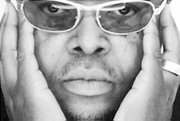New Magazine Blends Urban With quot;Phashion?quot;
Mykel Kilgour, former designer for Dion Scott, recently finished the groundwork for a new bicoastal urban fashion magazine called Phashion?, which he describes as “a neo-classic mix of controversial fashion, music, fine art, interiors and personalities, from a decidedly ethnic point of reference.”
“It poses the question as to what is fashion today,” said Kilgour. “It is not what it was 10 years ago today and we will raise the question in every issue.”
The original title of the magazine was Urban Flava, and although the word “urban” will no longer drive the title of the magazine, the designer emphasized that the content will still be largely driven by urban flavor.
“When I use the word ’urban,’ I mean it in a world-class sense, not in a hip-hop sense at all,” he said “I’m referring to how the world is being influenced by the urban lifestyle, even into the couture. Even the aristocratic upper crust is being influenced by urban style.”
Brian McKinney, a black Los Angeles-based designer who has provided Kilgour with the fashions that will appear on the cover of the premier issue of Phashion?, said that he was particularly interested in the magazine because of the concept of combining the streetwear side of urban fashion with better fashion by black designers.
“I’d like to see how the two mesh,” said McKinney. “Many [black designers] were taught that to be haute couture was to disassociate yourself from urban.”
Kilgour, through his publication, plans to redefine the word “urban,” which he said has been overused and underestimated in recent history without fully exploring its diverse expressions.
“’Urban’ is hip-hop or jazz, R&B or opera, urbanwear or couture, and indeed, inner city or suburbia,” he explained.
The magazine, which launches this month, will feature both men’s and women’s designs, but only from black and other ethnic designers, a focus Kilgour holds as unique.
“There has never been a publication that has shown African-American designers with any consistency,” said Kilgour. “[Phashion?] will feature photos in a world-class sense, not in whatever a ’black’ sense is supposed to be.”
McKinney was one of the flagship designers for menswear magazine Code and said that the experience with that publication “allowed me to see that there was a market for [urban fashion magazines] in the country.”
Kilgour explained that many fashion magazines relegate today’s black designers to urbanwear, and when they show the better lines, they fail to show them properly.
Kilgour said he has nothing against urban apparel, but calls it “a style of dressing, not a fashion design.”
“I’m glad that [urbanwear] is successful for so many people,” he continued. “It once again shows you that America will only embrace black talent to a certain level of understanding—you can go to Neiman Marcus and buy sweatshirts and denim [by black designers], but not a $500 gown.”
Kilgour has cultivated his position in the fashion industry over a nearly 10-year career as a designer.
Kilgour launched his first collection, Kilgour and Sweet, withhis wife and design partner, Celia Sweet. The collection sold in upscale retailers such as Henri Bendel as well as in the duo’s own boutiques. In 1996, the pair began designing for Dion Scott, a men’s made-to-measure company, with clients including Magic Johnson, Steve Harvey, Grant Hill, Don King and Snoop Dogg. They relocated to Los Angeles in 1999 when Kilgour became the creative director for Dion Scott.
In July 2000, Black Enterprise magazine featured Kilgour on the cover, exploring “Inside fashion—How the industry really works.”
As a black designer, he said he has seen the industry from a different perspective and plans to bring that story to the silver screen, with Blair Underwood as director and producer.
Phashion? is designed to be very candid in dealing with the difficulties faced by black designers. Kilgour plans to bring those same issues out in his film.
“It’s about how [black designers] are perceived by the media and in the industry, even by other black consumers,” he said.
Kilgour said that it frustrates him to see black rap stars use black designers when they are rising, only to abandon them once they have achieved success. He related the story of one successful black designer who was supplying up-and-coming rappers with clothes from his line—much of which was never returned.
“The whole thing is that as soon as they would get up on their feet, they [wouldn’t] even return calls,” he said.
Kilgour said that with his publication, he plans to provide a forum for the discussion of those issues.






















